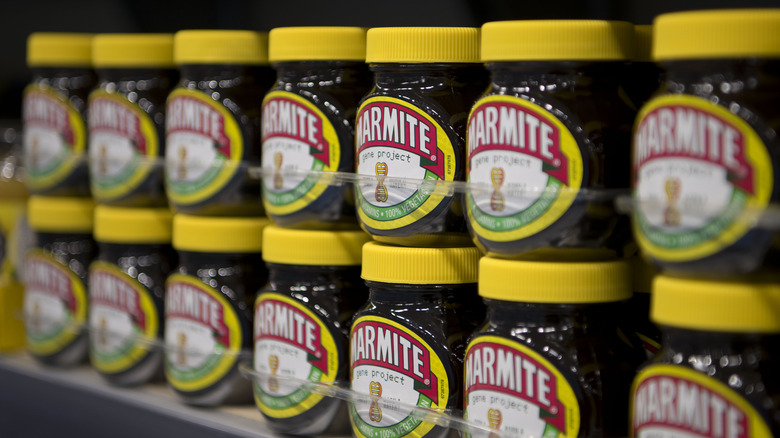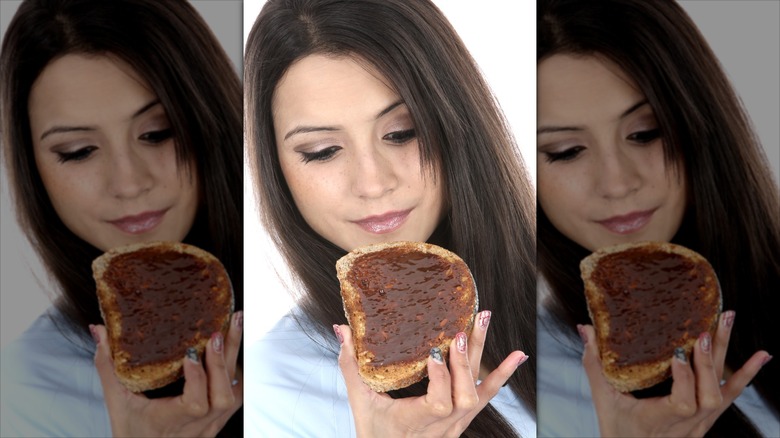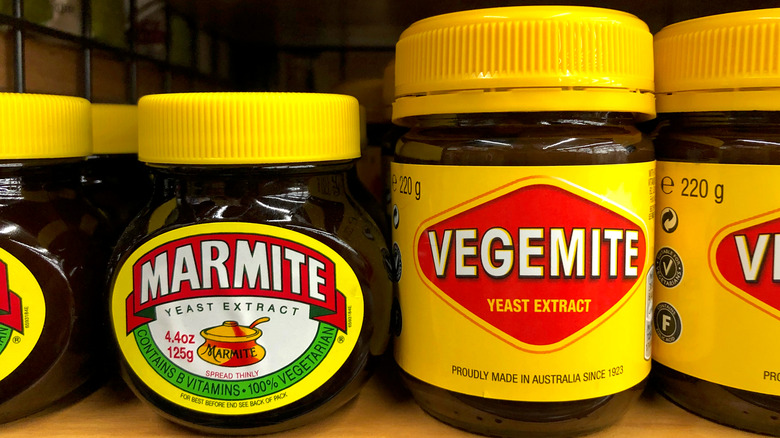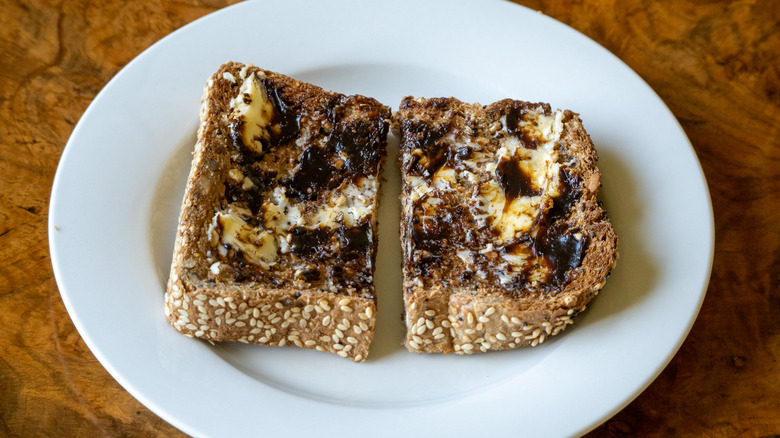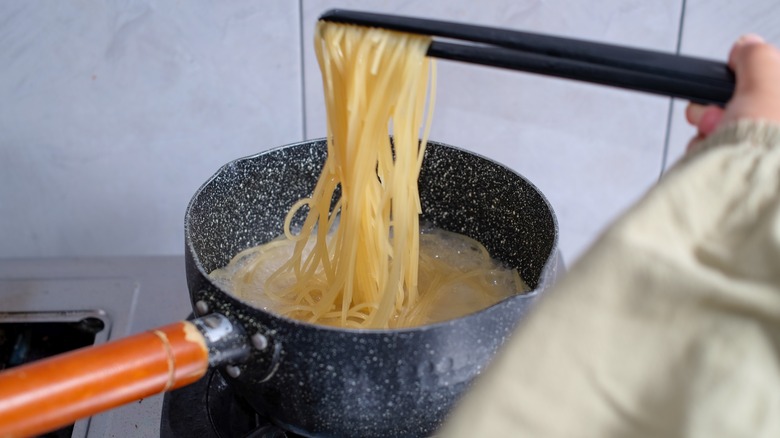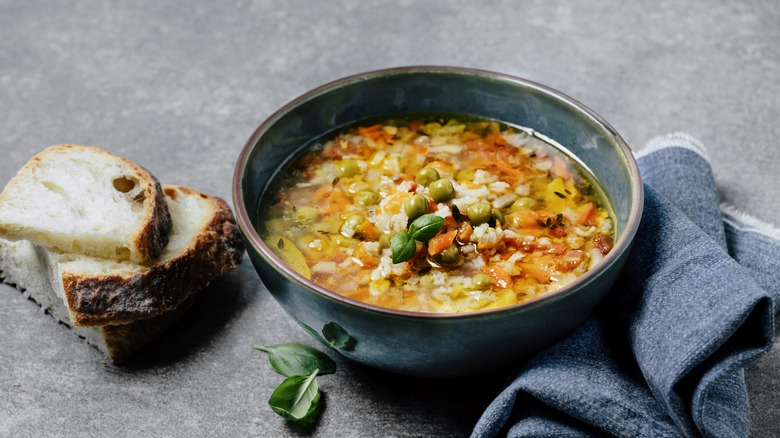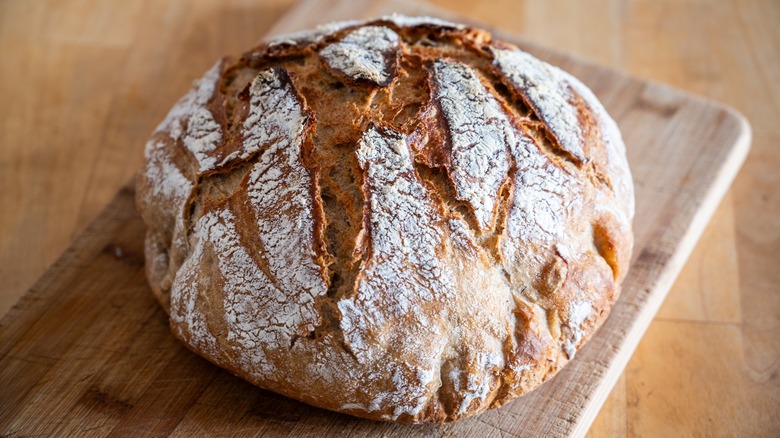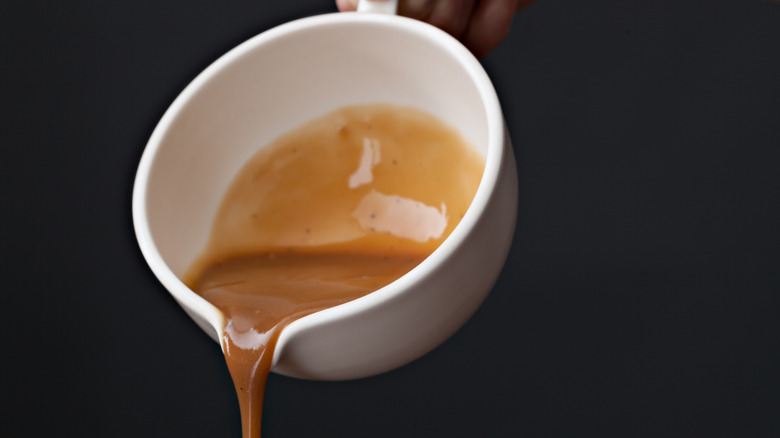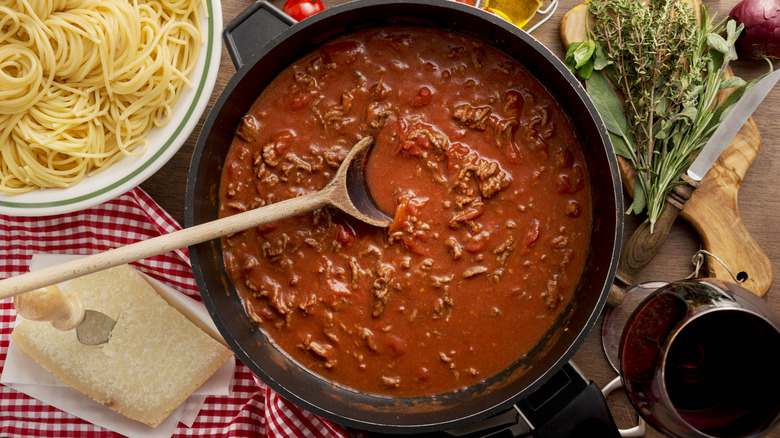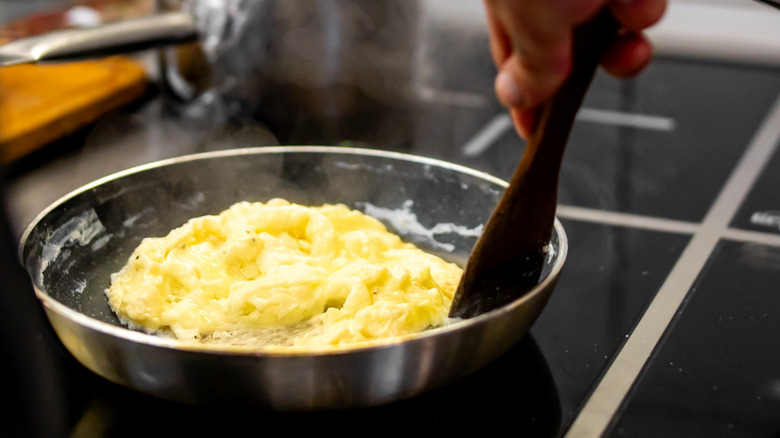What Is Marmite And What Can You Do With It?
British food can be baffling, and I say that as a Brit. Even the names are confusing to an outsider — bangers and mash, spotted dick, pease pudding. Nobody outside the U.K. knows what we're on about. And then there's the mystery that is Marmite. I grew up with the stuff, but many people from other parts of the globe are left scratching their heads wondering what Marmite is, and what you actually do with it.
A quick Google will tell you that it's a yeast extract but that doesn't come close to explaining it. Luckily, you have me, a British Marmite fan, to explain the ins and outs of this frankly bizarre viscous spread. I'm under no illusions. It's a weird substance, but it's delicious — to some — and way more versatile than most folks give it credit for.
I'm about to give you some insight into the history of Marmite, what it really is, what it tastes like, and how you can use it. Before you know it, you'll be saying "pip pip" and "alright mate" on your way to the British food aisle in your local supermarket, ready to clear the shelves of yeast extract.
What is Marmite?
What is Marmite? Well, it's divisive. This dark, sticky spread has been sparking debates in Britain since its invention in 1902. I say "invention" but Marmite was actually created accidentally. A German scientist, Justus Liebig, discovered that this highly concentrated yeast extract, that's a by-product of beer brewing, is edible. He founded the Marmite Food Company in Burton-on-Trent and the rest is history. Because why let anything go to waste when you could spread it on toast instead?
It's sold in jars, usually alongside other spreads for bread, such as jam and peanut butter, which tells you a bit about how it's generally used. However, it's a versatile substance, which you'll learn more about soon, so hang in there. It has an oddly viscous consistency, which often leaves the outside of the jar annoyingly sticky. And it's so iconic that you'll find Marmite flavored chips, nuts, and other snacks in U.K. grocery stores.
The name "Marmite" comes from a French earthenware pot used for cooking, and early jars even featured an image of one on the label. By the 1920s, Marmite had become a British pantry staple, marketed as a health food thanks to its high vitamin B content. During World War I, it was rationed out to soldiers, which tells you just how seriously the British take their savory spreads.
What does Marmite taste like?
Describing the taste of Marmite is a bit like describing the plot of a David Lynch film — no matter what you say, it'll sound strange to the uninitiated. Marmite is intensely savory, salty, and packed with umami flavor. Imagine soy sauce, miso, and a touch of burnt caramel had a very enthusiastic group hug, and you're halfway there. Its own slogan is "you either love it or hate it," which says a lot.
For Marmite lovers, it's packed with delicious savory flavor and there's nothing quite like it. For the haters — well, let's just say it's an acquired taste that they haven't acquired. It's strong, it's punchy, and it's not even sorry about it. Really, you have to try it to understand it, and then you have to try it again to make sure you got the gist.
Personally, I'm firmly in the "love it" camp, but I'll admit it's not for everyone. The secret is moderation. Spread it too thickly, and it will overwhelm toast. Stir too much into a recipe and it'll taste like Marmite and nothing else. But use just a little, and it perks up everything from cheese sandwiches to gravy. If you're trying it for the first time, tread lightly. Marmite isn't here to make friends — it wants to make a statement.
Are Marmite and Vegemite the same?
Okay, so now you understand what Marmite is ... but what about Vegemite? Is the only difference between them that one comes from England and the other from Australia? There's actually more to it than that so I'll try to explain the subtle difference between Marmite and Vegemite.
The first thing you'll notice is the difference in consistency. Marmite has a sticky consistency a bit like honey, while Vegemite is thicker and pastier — more like peanut butter. The biggest difference, though, is in the taste. Marmite has a slight sweetness alongside its savory punch. However, it does have a lot of tang to it that some people find unpleasant. Vegemite is a bit deeper, saltier, and more intense, with a yeastier flavor. However, it isn't tangy in the same way as Marmite, so some people find it milder.
That said, it's often about allegiances. The bulk of Brits would take Marmite over Vegemite any day. While if you ask an Australian if they have Marmite in their pantry, they might not be too pleased.
Marmite is traditionally eaten on toast or in sandwiches
If you're still baffled about what you actually do with Marmite, let's start with the basics. It's traditionally used as a spread for toast and sandwiches. While these aren't the only ways to use it, they're a good place to start.
The classic way to enjoy it is spread thinly on buttered toast. The thinness and the butter are both important and have saved many a newbie from Marmite overload. You can also make a simple Marmite sandwich in the same way — it was a staple of lunchboxes growing up.
But you don't have to eat Marmite alone on toast or in sandwiches. Fresh tomatoes are my go-to pairing. The sweetness of the tomatoes provides a delicious contrast to the savoriness and saltiness of the spread. Crack some black pepper on there and you're onto a winner. Or try pairing it with cheese. Sharp cheddar is the obvious choice, but even a mild Swiss comes alive with a hint of Marmite. It's great with cheese melted under the broiler or in a grilled cheese sandwich.
For anyone feeling adventurous, try spreading it alongside peanut butter. It sounds unhinged, but the salty-savory-sweet combo is delicious. It's so popular, in fact, that you can even buy Marmite peanut butter in the U.K.
It's also good with noodles
Marmite is destined for so much more than just toast. Let me introduce you to its secret second life as a noodle sauce. Adding Marmite is an easy way to get those yummy umami notes when stirred into hot, buttery spaghetti or any noodle dish that needs a little something extra.
This fact was popularised by Nigella Lawson's spaghetti recipe with an unexpected ingredient. Well, in this context it's not that unexpected. It's Marmite. This dish is super simple. It calls for a generous dollop of butter melted into a splash of pasta water, then whisked with Marmite before being tossed with spaghetti. The result is salty, savory, and delicious. Of course, being Marmite, it sparked controversy. To some, it sounded sacrilegious. To others, it was a genius hack for a budget-friendly dinner.
If Nigella's version isn't enough to sway you, Marmite's versatility with noodles extends beyond buttered spaghetti. A teaspoon mixed into a stir-fry sauce or a bowl of ramen adds a deep, savory base that tastes like you spent hours in the kitchen. It's a great shortcut to more salty, umami flavor.
Marmite deepens umami flavors in soups and stews
Soups and stews are meant to be rich, flavorful, and comforting but sometimes they need a bit of help. You can throw in all the carrots, celery, and bay leaves you like, but occasionally, they just taste ... fine. This is where Marmite can help you out.
It might seem odd to put something that's meant to be spread on toast in your soup, but it's not that strange once you really think about it. This is one of those British culinary quirks that actually makes sense. Marmite's salty, savory richness has a knack for filling in the flavor gaps you sometimes find in soups and stews. It can be especially helpful in vegetarian dishes where you might be missing the depth meat usually provides.
You only need a teaspoon or so to completely transform a broth. Stir it into a slightly lackluster soup or stew, and suddenly it tastes like it's been simmering all day. And if you're worried about Marmite haters, honestly, no one will know it's there unless you tell them. It's not about turning your soup into Marmite soup; it's about giving your dish that extra something. It's a great ingredient to have on hand whenever your dish needs a helping hand.
Pair it with hot cross buns
The combination of hot cross buns and Marmite has become the culinary pairing we never knew we needed. Thanks to a certain viral TikTok trend, this somewhat strange combo has come to the forefront. You take the bun, slice it hasselback-style, stuff it with melting cheese, and slather it with Marmite. TikTok is divided over this cheesy hot cross bun trend, but color us intrigued.
The sweet-savory combination works. And if you're worried that cheese would be weird with those spices, let me tell you that British people sometimes eat cheese with mince pies. It's a pairing that's way more delicious than it sounds. To make your own, cut slices in a hot cross bun almost all the way through, fan it out, and tuck in slices of cheese. Add a thin layer of Marmite to the bun, then bake it until the cheese bubbles and browns. It might not be a crowd pleaser but sometimes the best things aren't.
Try it in mac and cheese
Just when you thought mac and cheese couldn't get any better, along comes Marmite to prove us all wrong. We've written about how Vegemite is a delicious secret ingredient in mac and cheese but works just was well with Marmite. There are nuances between these two spreads but when used in small quantities, the results are the same.
I was skeptical when I tried this. Mac and cheese is simple in its deliciousness, and it seemed like Marmite might overpower it. But used sparingly, it makes the whole dish pop. The Marmite deepens the cheese flavor without overwhelming it, adding an umami complexity that can't be beaten. It's now an ingredient I reach for every time I make mac and cheese.
The technique is simple: melt butter, stir in flour, and whisk in milk to make your béchamel. Then, before you add the cheese, stir in a small amount of Marmite. A little goes a long way, so start with half a teaspoon and taste as you go. Once the Marmite is evenly mixed in, add your cheese and carry on as normal. Baked or stovetop, topped with breadcrumbs or draped with fresh tomatoes before entering the oven — however you like your mac and cheese, Marmite is an excellent addition.
Bake Marmite into bread and scones
If you're a bread baker looking to shake things up, Marmite might just be your new obsession. Stir it into the dough, and suddenly, a regular loaf is packed with salty, savory notes. Marmite bread is similar to cheese bread, but with a deeper umami punch. It pairs beautifully with soups, stews, or just a generous slather of butter. You can swirl Marmite into the dough for a marbled effect, knead it in for a uniform flavor, or even layer it with cheese before rolling up your dough like a savory cinnamon roll.
And don't stop at regular loaves of bread. It can work in all kinds of bread products from bagels to focaccia to English muffins. If it's bread-like, you can make a Marmite version — and you really should. Or you could step away from the yeast and try Marmite scones. They're flaky, buttery, and with just the right amount of savory kick. Eat them with a sharp cheddar or a dollop of cream cheese and you're in for a treat.
There are plenty of recipes out there for Marmite bread and other Marmite baked goods. However, if you have a recipe you love, added a spoonful or two of this yeast extract shouldn't change how the bake will turn out. You'll get similar results, texturally, but with loads more flavor.
Make gravy with Marmite
Here in the U.K. we love a classic brown gravy. We pour it over roast dinners, use it as a pie filling, and even ladle it onto bangers and mash. But most of the time, we aren't making gravy from scratch, instead reaching for gravy granules and they can be lackluster. This is where Marmite comes into its own. It easily adds depth to gravy, whether it comes from a packet or you're making it from scratch.
A teaspoon of Marmite in your gravy does wonders. You instantly add complexity and deep umami richness without having to simmer stock for hours. Its salty savoriness rounds out the flavors and makes even packet gravy or a simple recipe whipped up in a hurry taste like it was crafted with care.
It's especially brilliant if you're making vegetarian gravy. Without meat drippings to rely on, Marmite provides that otherwise elusive umami flavor. But it's not obvious in the finished sauce — assuming you don't overdo it. You'll notice the gravy is rich and delicious, but it won't taste of Marmite, so nobody will guess your secret.
Use Marmite in spaghetti sauce
If you've ever felt like your spaghetti sauce could use just a little extra oomph, you can guess what I'm about to tell you. Yup, Marmite rides again, making your sauce even more savory and delicious. It's the British ingredient your spaghetti sauce is missing — and you can see why we're so obsessed with it over this side of the pond. It can pull off practically anything. Just don't ask it to do the dishes after.
A small spoonful stirred into the simmering pot takes your sauce to a new level of savory. It deepens the tomato's natural sweetness and balances out its acidity. You can make your sauce taste fancy without needing hours of slow cooking or a splash of decent wine you'd rather drink. It's a lifesaver for vegetarian pasta sauces, giving them that savory depth people usually expect from something simmered with sausage or pancetta. So next time spaghetti night is coming up, don't forget to put Marmite on your grocery list.
Add Marmite to savory muffins
Forget blueberry, move over lemon-poppyseed, savory muffins are where it's at. They're even better for breakfast than the sweet ones because you don't have to deal with a sugar crash, and you can invite your new friend Marmite to the party.
All you need to do is mix a small amount of Marmite right into the batter and you've got all that great flavor in there. You'll find plenty of Marmite muffin recipes online if you want to try it out or you can doctor a recipe you already use. Marmite is delicious with ingredients like cheddar, herbs, and caramelized onion in muffins.
If you don't want to eat these muffins straight up, they're perfect with a bowl of soup or as a stand-in for bread rolls at dinner. But honestly, I love simply splitting one open and slathering on some butter while it's still warm. Marmite muffins may not be conventional, but that's part of their charm. You can also experiment with all kinds of other savory baked goods. Marmite is versatile enough to use practically anywhere.
Whip up Marmite eggs
Eggs and Marmite are two breakfast staples but you don't usually hear them discussed in the same breath. That's a shame, though, because whisking Marmite into your eggs is an easy way to make them incredibly flavorful. If you're sick of bland scrambled eggs, it's something you should add to your repertoire.
Scrambled eggs are a prime contender for the umami treatment this spread brings. A little Marmite whisked with the eggs or melted into the butter before you add your beaten eggs is all you need. It adds a savory depth that brings out the natural richness of the eggs without overwhelming them.
If you're into baked eggs, try dotting a bit of Marmite on the edges of the ramekin before cracking in the egg and adding cream or cheese. As it bakes, the Marmite melds with the other ingredients, creating pockets of savory goodness with every bite. It's perfect for lazy weekend mornings when you want something that looks fancy but doesn't require too much effort.
Marmite is also amazing in an omelette. Whisk it directly into the eggs before cooking, then fill it with mushrooms, cheese, or anything else you fancy. Just be warned — once you've tried Marmite eggs, plain eggs won't seem half as interesting.
